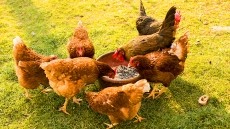Underused pasture land in Brazil key to soy expansion, but ports remain bottleneck: Rabobank

Brazil has about 75m hectares of underused pasture land that could generate feed crops, including soybeans, with additional investment in the country’s infrastructure to bring products like fertilizer to producing regions and crops to market, said Rabobank analysts, Renato Rasmussen and Victor Ikeda, in a study on Brazil's agriculture potential.
Most of the expansion, they said, is expected through use of such areas rather than through deforestation and the clearing of new areas. There is a growing lobby from the industry, producers and NGO backed Soy Moratorium to the Roundtable on Responsible Soy (RTRS) to the Consumer Goods Forum the conversion of any land to produce commodities.
Such underused pasture land that could increase crop production makes Brazil a strong candidate to meet future world feed grain needs, especially for soybeans, said Rasmussen and Ikeda.
They said the outlook for the global demand for grains and oilseeds is very promising for the near future, as the dietary shift toward foods with higher protein content in developing countries, particularly in China and India, materializes.
“Global demand for animal feed is also set to increase, at an annual rate of 2.7% over the next decade,” noted the authors. “This will boost grain consumption, since grain comprises over 70% of conventional feed ingredients.”
This view, they said, is supported by the 120% rise in soy exports Brazil has experienced over this past decade, leaping from 25m tons in 2006 to 55m tons in 2015.
The country has one of the longest coasts lines in the world, with multiple inland ports and seaports. It also has a good growing climate with adequate precipitation and freshwater reserves.
“Current market participants and potential new entrants with a long-term view can find a unique combination between agricultural potential and investment needs in Brazil,” continued Rasmussen and Ikeda. “If on the one hand, the country’s infrastructure problems represent higher production costs and loss of competitiveness, they also represent an array of opportunity well worth considering.”
Remaining challenges
However, Brazil’s move to increase production does face ongoing challenges, they said. These include the lack of ports suitable for shipping grains, and infrastructure problems.
Many of the country’s ports are too shallow, have limited handing capacity or environmental issues to prevent their use, said the analysts.
“In recent years, Brazil faced limitation in servicing some of its key grain-producing regions and, in particular, its rapidly expanding agricultural frontiers,” they said. “While the country’s top four grain-exporting ports are situated on its southern coast – accounting for over 70% of Brazil’s total exported volume – most of the production expansion has been happening in its less developed and more remote regions, in the north-east and center-west.”
One example of this is that Mato Grosso – on of the largest grain-producing and exporting states – has upped its planted land by about 40% to 9.1m hectares in the last five years, they said. But to reach export markets, about 73% of the crop has to be flown to the southern ports.
Farmers in those regions receive lower prices for their products because of the transport expenses, said Rasmussen and Ikeda. Most the roads in the country also are not paved, adding complications to the transport of grain or heavy cargo.
Similarly, products like fertilizers have a harder time reaching producers in the north as they are delivered in southern ports, they said. “With increased availability of ports in the Amazon region, such as Barcarena or Santarem, distances to the export ports for producers in northern Mato Grosso can be reduced by a third, potentially lowering freight costs by up to 40%,” they added.
Investment
Such challenges could be overcome with greater investment in the country’s infrastructure, said Rasmussen and Ikeda, and some large companies started getting more involved in about 2013.
“The expansion stemming from the port investment now underway is expected to translate into an additional soybean export volume of 16m tons by 2025, or an increment of 30% on total Brazilian soybean shipments in 2015,” they said.
Some of these has already been seen as two new ports in Barcarena and Santarem have helped soybean exports reach 2.2m tons and 1m tons, respectively, from the state of Para, they said. Previously exports in that area amounted to almost nothing.
“Such a rise in port capacity also means the battle across trading houses for sourcing ever-increasing grain volumes is heating up in Brazil,” said the authors.
Additionally, in the last five years the two traditional export corridors have expanded to become four, they said. These include the north-west, northern, north-east and southern corridors.
















